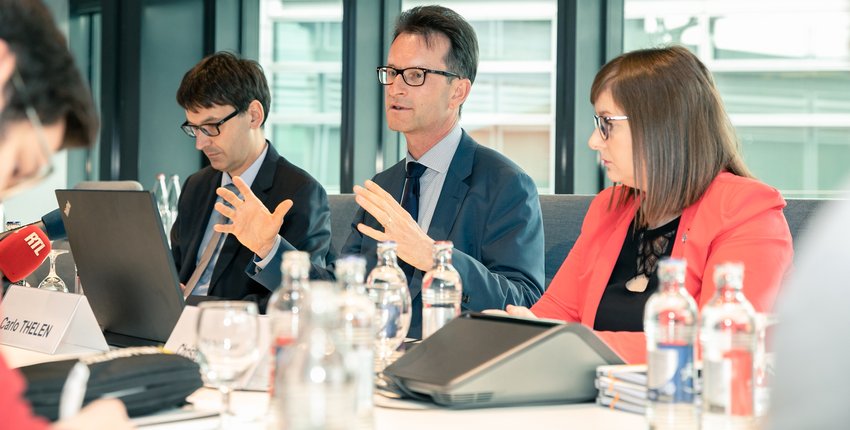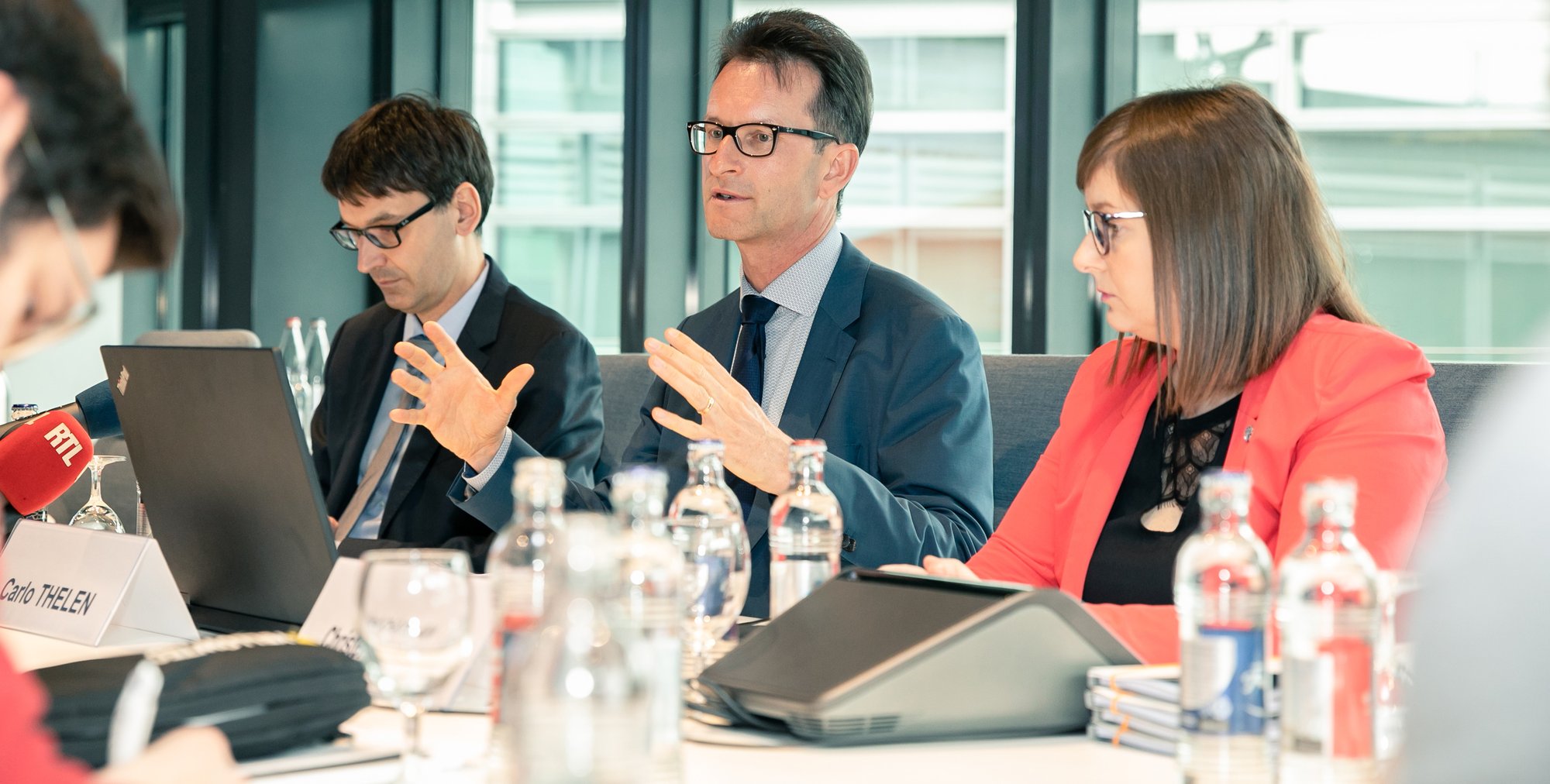
The Chamber of Commerce’s opinion on the budget

The 2019 draft budget is the first budget package of the current legislature, including the draft budget for 2019 as well as the multiannual financial planning bill (Projet de Loi de Programmation des Finances Publiques, PLPFP) for 2018 to 2022. This package was presented to the Chamber of Deputies on Tuesday, 5 March, 2019.
The Chamber of Commerce welcomes the surplus budget from the central administration in 2018, which is due in large part to exceptional returns from businesses, although fears a slowdown may follow this extraordinary increase in revenue. Furthermore, the risks surrounding Luxembourg’s public finances have revealed a significant gap between macroeconomic forecasts and the actual numbers, which could reveal surprises that the governmental authorities have not prepared for in terms of security measures and budgetary margins.
The project under review is innovative in a number of ways, including a new presentation for the accounts, but other aspects leave much to be desired. While the Chamber of Commerce welcomes the substantial budget surplus from government agencies in 2018, which reached 2.6% of the GDP, it also notes that this result reflects to a large extent a significant increase in taxes paid by companies in 2017 and 2018. The government has certainly been cautious when estimating revenues in 2019, for example by estimating an 11% drop in corporate income tax this year, after an increase of 20.5% in 2017 and 17.1% in 2018. Numerous uncertainties, either international (Brexit, trade tensions, slowdown in the euro zone, etc.), or national (for example, expenditures not decreasing, as foreseen, which could cost up to EUR 1.5 billion by 2022), raise fears that the precautions taken may be insufficient, especially as the continued increase in employment, particularly for border workers, could generate additional public investment needs. Therefore, it would have been better to plan for greater budget margins in order to be prepared for possible surprises.
Robust growth is of course desirable, but it must take a more qualitative turn (that is to say, more resource-efficient), otherwise Luxembourg will be faced with increasing various bottlenecks in relation to mobility, housing, training, and a shortage of sufficiently qualified workers – which could potentially be very costly economically and in terms of budget. Hence the need to generate substantial new productivity gains and to make additional efforts to standardise public investment. All this while also reinforcing an attractiveness that has been challenged by international tax fluctuations, incessant increasing minimum social wage, and by new administrative and organisational constraints (for example, increased controls and regulations, bank holidays, and other additional holidays, etc.). Competitiveness, especially concerning fiscal matters (including for holding companies, which in 2017 generated about EUR 1.4 billion of public revenue, in addition to social contributions and indirect taxes), is essential for Luxembourg’s open economy.
The Chamber of Commerce’s opinion in ten points
1. A GDP of 72 billion in 2022 ... or a tax loss of 1 billion?
According to the projections on which the 2018-2022 PLPFP is based, the nominal GDP would increase from 55 billion in 2017 to about 72 billion in 2022. This latter figure is based in particular on optimistic macroeconomic projections for 2019 and 2020, including a growth rate of 3.0% in 2019 and 3.8% in 2020. However, in the current national and international context, it is difficult to explain such an acceleration of growth in 2020. Another cue for caution is the first estimate for the GDP in 2018, with growth at 2.6% instead of 3.0%, according to the draft budget.
The European Commission's growth forecasts are more realistic in this context, with real GDP growth limited to 2.5% in 2019 and 2.6% the following year. This could result in a cumulative loss of up to EUR 1 billion by 2022.
2. Continual increases in public spending
Compared to the very first PLPFP, tabled in October 2014, the central administration’s expenditures for 2018 in the current PLPFP (March 2019) are literally levitating. In other words, the good returns on public finances in 2018 were due to a boost in revenue and not spending cuts. Meanwhile, according to the multiannual programming from October 2014, total expenditures in 2018 were meant to reach EUR 17,580 million, but are currently estimated at EUR 18,540 million – a difference of nearly EUR 1 billion. The composition effect is also unfortunate. Employee compensation (+600 million, compared to 2014’s estimate for 2018) and the intermediate consumption (+180 million) are showing a sharp divergence. On the other hand, investments are undergoing a clear downward shift of around EUR 300 million for these two items combined.
Another reason for concern, for all public administrations, is that the current PLPFP projects a pronounced slowdown in the growth of current expenditures from 2019 to 2022 (+4.7% per year on average), compared to the average from 2000 to 2017 (+6.1% per year). The Chamber of Commerce welcomes this, but notes in parallel that if current expenditures were to continue their momentum of +6.1% per year, they would suffer a slippage of some 500 million by 2020, 1 billion in 2021, and 1.5 billion in 2022. The surplus budget currently expected by the PLPFP could then collapse or even disappear altogether.
3. Minimising expenditures related to employee compensation
Sustaining a balanced budget, or a surplus budget, is not possible without controlling expenditures – revenue cannot continue at the same pace as in recent years.
But this will not happen spontaneously, given the rigid and difficult to reverse nature of many current expenditures. The salaries of state employees (and social and family expenses) are a striking example of the situation. In 2019, the position for “remuneration of state employees” will increase by 7.5% compared to 2018. This represents 23.4% of the total expenditures of the central administration and 7.5% of the GDP. Between 2010 and 2018, this position increased by 50%, from EUR 2.8 billion to EUR 4.3 billion. Lastly, during the period 2019 to 2022 covered by the PLPFP, the average annual increase for remuneration of salaried state employees will be 5.6%. These developments accentuate the rigidity of public spending, which could prove very damaging in a possible future economic slowdown. Room to implement proactive policies is shrinking every year as recurrent costs leave less and less room for budgetary measures that could target more proactive plans.
4. Drop in Corporate Income Tax, a relief for businesses?
The draft budget proposes, among other tax measures, a 1 percentage point reduction from 18% to 17% in the corporate income tax (l’impôt sur le revenu des collectivités, IRC) rate. Considering the communal business tax (l’impôt commercial communal, ICC) prevailing in the territory of Luxembourg City and the national Employment Fund (Fonds pour l'Emploi) levy, the nominal overall rate would be 24.94%, compared to 26.01% currently. In addition, the bracket to which the minimum IRC rate of 15% applies has grown.
The Chamber of Commerce welcomes these new provisions. At the same time, there are two considerations to make. First, the new standard listed rate of almost 25% remains well above the median corporate tax rate in the European Union – 21% – and this, in an international context that is increasingly favourable to competition by rates in light of a trend towards both growing tax bases and the gradual harmonisation of tax bases. Secondly, the Chamber of Commerce notes that, by 2019-2022, the changes announced will not, in principle, lead to a reduction in the tax burden on businesses. It therefore fears that in fact the announced changes will not be fully offset by the widening of the tax base resulting from various international developments. Finally, beyond a rather modest decrease in the IRC, the Chamber of Commerce would have liked significant advances in other tax aspects, for example eliminating the withholding of tax on outgoing dividends and wealth tax.
5. The central government’s balance
According to the budget, the central government had a surplus of EUR 121 million in 2018. However, this is the result of exceptional, largely non-recurrent increases in revenue – in particular the IRC, wealth tax, and tax withheld on capital income, the proceeds of which in 2018 increased by 17%, 31% and 36%, respectively, compared to 2017. This is also short-lived as in 2019 the central government would return to a deficit of more than EUR 600 million, with expenditures exceeding revenues, yet a spectacular recovery is forecast for 2022, the last year covered by the PLPFP.
The Chamber of Commerce believes that this budget trajectory is relatively unambitious, as evidenced by the entire period covered by the PLPFP. The coalition agreement for the 2018-2023 legislature also seems to be generous in terms of intentions for new public spending, and many of these measures do not seem to have been budgeted yet (for example, free access to shelter homes).
6. The new medium-term objective (MTO) for the budget: 0.5% makes a comeback
The Chamber of Commerce commends the adoption by the authorities of a more stringent medium-term objective for structural balance (meaning a budgetary balance that takes into account structural effects) for the public administration (the MTO, which sets the tone at the European level), since it has gone from -0.5% of GDP to +0.5% for the years 2020 to 2022. This is a first glimpse of the foreseeable inflation of future pension expenditures. It is also a confirmation for the Chamber of Commerce, which, as early as April 2016, warned against the choice of a less demanding MTO for the three years of 2017, 2018, and 2019. Maintaining an objective of a +0.5% GDP during this period would have made it possible to better highlight the budgetary stability of Luxembourg, in order not to send a signal of budgetary slackening to the outside world.
The Chamber of Commerce also notes that this official objective of +0.5%, this anchoring of budgetary policy, is based on the assumption of a gradual convergence of the debt ratio to 60% and on a pre-financing of only one third of future expenditures related to demographic aging and the gradual retirement of workers, in particular non-resident workers. The choice of a debt target compatible with the government objective (debt consistently below 30% of the GDP) would give rise to an MTO of minimum +1.7% of the GDP. In addition, if the pre-financing of the cost of aging were to increase to 50%, the MTO would increase to +3.2% of the GDP.
7. Huge risks
An ambitious budgetary objective would be all the more necessary since the current economic context is characterised by multiple uncertainties. The sensitivity analysis carried out in the budget has already made it possible to define the scope of risks and uncertainties (trade and Brexit tensions in particular), but other more specific risks already largely identified in November 2018 by the National Economic and Financial Committee (Comité économique et financier national, CEFN) should also be considered. An illustrative list, and not exhaustive, of some of those risks includes the exact cost of unemployment benefits granted to non-residents in the future, the pressure exerted by demographic developments in terms of infrastructure expenditures, the loss of competitiveness in business taxation, climate commitments and the possible decline of the “petrol pump tourist”, and Luxembourg’s position with the financial sector (particularly the volatility of stock markets).
8. Social security: Problems at hand
Another major risk is, of course, social security. The European Working Group on Aging and the Luxembourg Pensions Working Group have clearly highlighted the difficulties of long-term financing, for pensions in particular, which the Chamber of Commerce will not go into here. This said, various problems have already crystallised in recent years. Even before 2025, the operational balance of the general pension scheme could be in the negative according to the Luxembourg social security authorities (L'Inspection générale de la sécurité sociale, IGSS), or the gradual deterioration, recorded since 2000, of the balance of the social security funds, which has passed from around 2.5% of the GDP in 2000 to 1.6% today. According to the PLPFP, this surplus of 1.6% would last until 2022, but this result depends largely on the supposedly slower growth in social benefits from 2019 to 2022.
9. Not all policies bring value-add
The importance of implementing a digital transformation strategy has been well documented in the budget documents, but the continued increase in the number of staff in the administration shows that the increase in labour productivity is not on the agenda. Another condition related to qualitative growth is the development of new areas of economic activity, which is a priority for the government. Indeed, the government has announced its intention to invest in the acquisition of land in order to create new areas of activity on a national and regional level.
The government has also announced a substantial increase in the minimum social wage at the expense of companies and via a new tax credit. Also noteworthy is an increase in excise duties, the effect of which is yet difficult to define, and various tax measures noted in detail in the opinion of the Chamber of Commerce.
10. Time passes but results are lacking for the Zukunftspak budgetary project
A few figures are enough to summarise the situation: the government programme at the end of 2013 mentioned savings measures of EUR 1,500 million by 2018. The current PLPFP, however, only mentioned EUR 567 million, of which 70% concerns the increase of certain VAT rates.
* * * * *
The Chamber of Commerce considers that any budget must be part of an overall strategy that includes two pillars: on the one hand, reinforcing budgetary margins, which currently are insufficient for increasing risks and uncertainties (the Chamber Commerce proposes consolidation measures of some EUR 1.5 billion), and on the other hand, a vast expenditure shift aimed at a real qualitative leap in Luxembourg’s economy. More emphasis needs to be placed on effective education and training in view of the growing recruitment difficulties experienced by companies, on research and development and better coordination of the latter with companies, and on better infrastructure for transport, telecommunication, and housing. All of this would make it possible to jump-start the currently lagging productivity of Luxembourg. Indeed, the 2019 draft budget includes plans to stimulate digitalisation of the economy, business parks, spatial planning, and research and development, but these plans should be reinforced.
The full text of the opinion of the Chamber of Commerce on the budget is available here.


